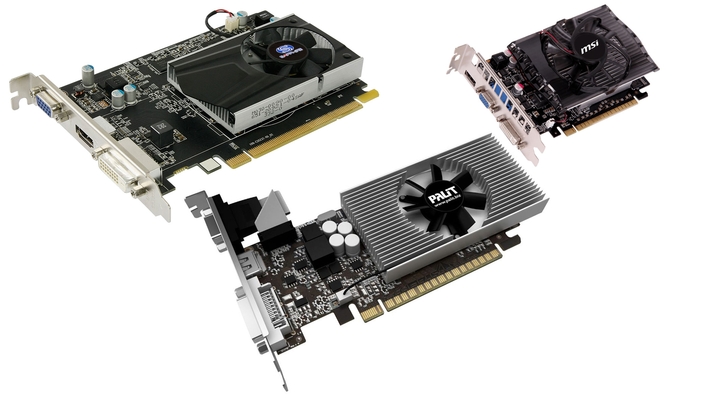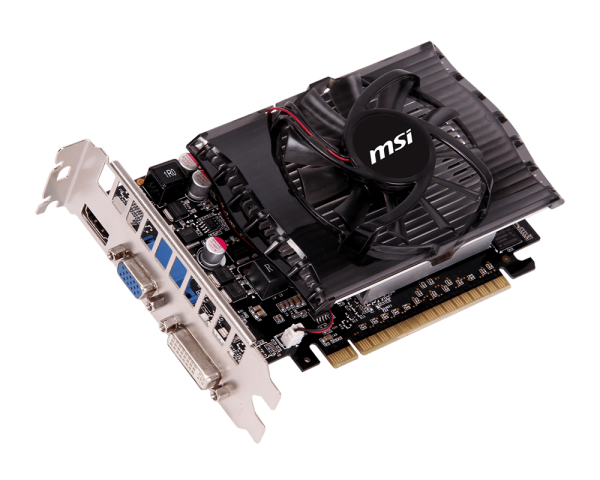Built around the bargain-basement AMD Radeon R7 240 and the nVidia GeForce GT 730 GPUs, these graphics cards really are the bare minimum that you’ll want if you’re to engage in any sort of gaming. While these cards retail for roughly the same price, they go about their business in radically different ways. Well, at least, part of the time. That’s because the GT 730, confusingly, is available in several different flavours. Here’s our Radeon R7 240 vs GeForce GT 730 review. If you’re considering a 730 GT, the first choice to make is whether you go for a 1GB, 2GB, or 4GB version. The latter doesn’t make an awful lot of sense, since 4GB really is overkill for a card costing this little, while the price of the RAM pushes it well beyond the £60 mark – if you’re spending this amount of money, you’ll almost certainly fare better if you lift your ambitions to the GT 740, or the Radeon R7 250X. However, 1GB vs 2GB is a trickier decision. The difference will amount to an extra £3-£5, and you’ll probably net a couple of additional frames per game. Most of the time, you won’t be making much use of the extra RAM, but for what little extra it costs to buy, we would recommend the 2GB version. See also: the best budget graphics cards Of far more importance, though, will be the memory bus and core clock speed. Most of the GT 730s now come with a 64bit memory interface. Originally, it was thought that the 1GB versions would carry a 128bit bus, while the 2GB cards would have only a 64bit bus. As it turns out though, most 730 card manufacturers have decided to use the 64bit interface, regardless of whether there’s 1GB or 2GB onboard. The Palit GeForce GT 730 Silent is a perfect example of this. Now, in our opinion, that’s a mistake, as the narrow 64bit bus really does keep a lid on overall performance. So we’ve also brought in the MSI GeForce GT 730 2048MB. This costs an extra £3, and is, again, a 2GB version. However, a 128 bus is included. As it happens, it also comes with a vastly reduced core clock speed – 700MHz rather than the Palit’s 902MHz – and you can expect this reduced core clock to be the price you pay for that bigger bus. We’ll come to what all of this means shortly. In the meantime, though, let’s introduce the competition from AMD. The Radeon R7 240 GPU, seen here in this overclocked Sapphire edition, is far more straightforward. And, in fact, exists as a sort of midway point between the two 730s. There are 64bit versions of the R7 240, although the 128bit bus-version is rather more popular. And like both of the other cards, it’s kitted out with 2GB of GDDR3 RAM – more than ample for a card at this price-point. GDDR3 is a rather limited form of DDR RAM. Whereas GDDR5 memory can effectively quadruple the basic speed of the memory, GDDR3 has no more than a doubling effect. Both the Sapphire Radeon and the 128bit MSI GT 730 have standard memory clock speed of 900MHz, which is then doubled by the GDDR3 to produce an ‘effective’ figure of 1800MHz. The 64bit Palit GT 730, though, comes with a slightly reduced standard memory clock of 800MHz, which effectively doubles to just 1600MHz. None of this is very significant, as it’s really the size of the bus that counts. And here the Palit fares very badly indeed, producing a mediocre memory bandwidth rate of just 12.8GB/sec. Both of the 128bit versions, on the other hand, produce bandwidth rates of 28.8GB/sec. The memory bandwidth is a very good indicator of how much juggling room the GPU has, so we can expect the 64bit Palit GT 730 to feel rather swamped and out of its depth compared to its 128bit rivals. There is some succour for the Palit, though, and while it fares badly on memory clocks, the actual core clock is the best at this price-point. Its mighty 902MHz easily defeats the Radeon R7 240’s 780MHz, and destroys the MSI 128bit 730 GT’s core clock of 700MHz. Indeed, the 128bit 730 GT comes out of this comparison rather badly. The Radeon R7 240 might trail on core clock speed, but it gains revenge through having more texture units (20 in total) than the 730 GPUs – all of the 730 GTs have a mere 16 texture units. Inferior in terms of both TUs and clock speeds, the 128bit MSI 730 GT hits a texture fill rate of just 11.2GT/sec. Its Palit-branded sibling finishes comfortably ahead on 14.4GT/sec. The Radeon R7 240, though, has the best rate of all, finishing with 15.6GT/sec – a clear winner thanks to its greater number of texture units.
The Radeon has fewer stream processors (320) than the two 730 GTs (384 each). As we’ll see later on, AMD architecture tends to lead to more rather than fewer stream processors, so this is a surprise. Otherwise, though, the cards are rather similar. All have the same number of ports – one each of DVI, HDMI, and VGA – and none of them require extra connectors from the PSU. There’s very little to choose between them on power consumption. The 730s have a slightly higher TDP, but there was rarely more than five watts between the cards during testing. All three cards were extremely discreet, with the Sapphire and Palit being marginally quieter than the MSI.
Radeon R7 240 vs GeForce GT 730 review: benchmarks
When it comes to benchmarking, the scores are fairly close together. In truth, these three cards are much of a muchness. The 128bit MSI GT 730 is the fastest of the three, but not by much – the lead is rarely more than about 2.2 frames per second over the Radeon R7 240 Boost. The 64bit Palit GT 730 is the slowest card, but even here, the difference to the 128bit version is typically less than 3fps. The 128bit interface is making a difference, but only just. Of course, there is a rather more brutal truth to these figures – none of these £45 cards are really good enough. Even at a resolution of 1680×1050, all three are generally struggling to break the 30fps mark. 30fps is crucial, because below this point, the game will be almost too sluggish to play properly. Significantly, though, the 128bit MSI GT 730 is the only one of the three to break the 30fps barrier in more than one of our four games. And even that card falls short in Bioshock. You could go lower still in terms of resolution, but if you want to get anything approaching a decent level of detail, you’ll need to set your sights higher.


